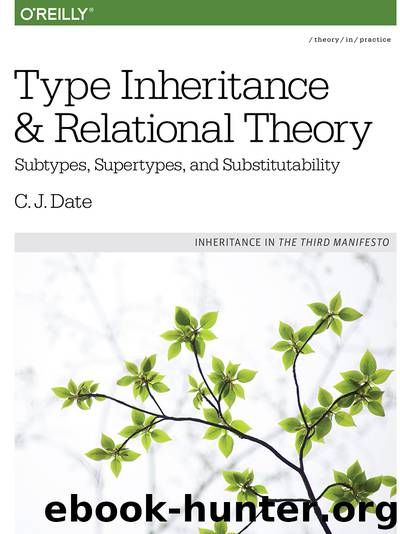Type Inheritance and Relational Theory by C.J. Date

Author:C.J. Date
Language: eng
Format: epub
Publisher: O'Reilly Media
Published: 2016-03-13T16:00:00+00:00
E := CIRCLE ( LENGTH ( 5.0 ) , POINT ( 1.0 , 1.0 ) ) ;
XC := TREAT_AS_PTR_TO_CIRCLE ( PTR_TO ( E ) ) ;
THE_A ( E ) := LENGTH ( 6.0 ) ;
Ignoring irrelevant aspects, a relational analog of this example might involve relation variables (i.e., relvars) that look something like this:
VAR R1 BASE RELATION { K ELLIPSE , ... } KEY { K } ;
VAR R2 BASE RELATION { K CIRCLE , ... } KEY { ... }
FOREIGN KEY { K } REFERENCES R1 ;
For simplicity, assume no referential actions—cascade update, etc.—are specified (this simplifying assumption doesn’t affect the argument in any material respect). Assume also that both relvars are initially empty.
Observe now that every value of K in R1 that matches some value of K in R2 must be of type CIRCLE, not just of type ELLIPSE. So let’s insert a tuple into each of the two relvars:
INSERT R1 RELATION { TUPLE
{ K CIRCLE ( LENGTH ( 5.0 ) , POINT ( 1.0 , 1.0 ) ) } , ... } ;
Download
This site does not store any files on its server. We only index and link to content provided by other sites. Please contact the content providers to delete copyright contents if any and email us, we'll remove relevant links or contents immediately.
Algorithms of the Intelligent Web by Haralambos Marmanis;Dmitry Babenko(8522)
Test-Driven Development with Java by Alan Mellor(7404)
Data Augmentation with Python by Duc Haba(7298)
Principles of Data Fabric by Sonia Mezzetta(7047)
Learn Blender Simulations the Right Way by Stephen Pearson(6983)
Microservices with Spring Boot 3 and Spring Cloud by Magnus Larsson(6802)
RPA Solution Architect's Handbook by Sachin Sahgal(6215)
Hadoop in Practice by Alex Holmes(6031)
The Infinite Retina by Robert Scoble Irena Cronin(5914)
Jquery UI in Action : Master the concepts Of Jquery UI: A Step By Step Approach by ANMOL GOYAL(5873)
Big Data Analysis with Python by Ivan Marin(5720)
Life 3.0: Being Human in the Age of Artificial Intelligence by Tegmark Max(5402)
Pretrain Vision and Large Language Models in Python by Emily Webber(4683)
Infrastructure as Code for Beginners by Russ McKendrick(4462)
WordPress Plugin Development Cookbook by Yannick Lefebvre(4194)
Functional Programming in JavaScript by Mantyla Dan(4124)
The Age of Surveillance Capitalism by Shoshana Zuboff(4116)
Embracing Microservices Design by Ovais Mehboob Ahmed Khan Nabil Siddiqui and Timothy Oleson(3981)
Applied Machine Learning for Healthcare and Life Sciences Using AWS by Ujjwal Ratan(3958)
